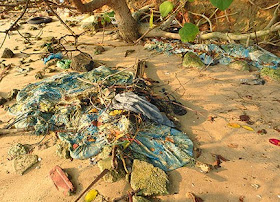There are also many other activities, managed by many different agencies, that impact the quality of the water at the East Johor Strait.
This pink helium balloon was still floating in the air. It might have been a Happy Birthday for some Princess, but it is not happy news for marine life when a balloon is not disposed off properly and ends up on the shore. Balloons kill sea turtles painfully and slowly. Please do not release helium balloons!
There is a stretch of Pasir Ris beach on the west that lies outside the Park proper and is thus not cleaned regularly. Here, we can see the full array of trash that washes up on the shore.
A large heavy duty net that looks like the kind used to construct 'cages' at the fish farms.
Large blue drums above the high water mark. They probably didn't float there.
The door of a small refrigerator, above the high water mark. It probably didn't float to the shore.Various tarpaulin sheets used often in fish farms.
An abandoned nylon fishing net. It will kill until it is removed.
How did this bright orange safety vest end up on this branch well above the high water mark? It did not float there. Was it purposely hung there to mark the spot for dumping? Trash on our recreational beaches costs taxpayers $1.4m a year to clean up! Wouldn't it make more sense to prevent as much trash from being tossed into the sea in the first place? By providing fish farms with a reasonable and practical way to dispose of their trash responsibly.
The long blue 'security barrier' managed by the Police Coast Guard eventually gets encrusted with mussels and other marine life. These are regularly scrapped off. The floating structure next to the barrier is probably used for this activity. The marine life is just dumped into the water where they rot.
The land beyond the shore appears to belong to Mindef. Does Mindef ensure there is no illegal dumping from the landward side?
On the shore, this appears to be a packet of military issued food?
There is a great deal of litter on the low water mark even within the Park proper as cleaners have lots to do just cleaning the high water line.
Palm oil waste washes up in tiny to large pieces everywhere at Pasir Ris, and are seen floating among the fish farms as well.
This photo shows some of the other activities that impact water quality at Pasir Ris. A series of large industrial pipes that possibly suck in as well as drain out water onto the shore. In the distance, massive coastal works next to Lorong Halus Jetty (I was told the work was to construct a jetty for the Commandos). Way in the hazy distance, Pasir Gudang Port in Johor.
One of the pipes is leaking spectacularly and has been doing so for years. These apparently lead to fish farms on land, which were also affected during the recent mass fish deaths. More about these mysterious pipes in this old post.
These are just a few of the great many activities going on in Singapore that can affect the marine ecosystems in the East Johor Strait.
 |
| click on image for larger view. |
Yes, good coastal water quality begins well upstream. All agencies and the public need to do their part so that we can enjoy good water. Which is good for marine life, good for fish farms and good for people.
Despite these pressures, there are lush seagrass meadows and marine life at Pasir Ris! More about the marinelife at Pasir Ris today.
Related posts
- What is AVA doing about dead farm fishes being dumped into the water?
- Trashy Pasir Park and fish farms
- Mysterious goings on at Pasir Ris
- Trashy Pasir Ris: where does the rubbish come from?
- Pasir Ris: mystery pipes discharging to the sea
- Pasir Ris floating security barrier: some questions
- Update on mass fish deaths in the East Johor Strait
















